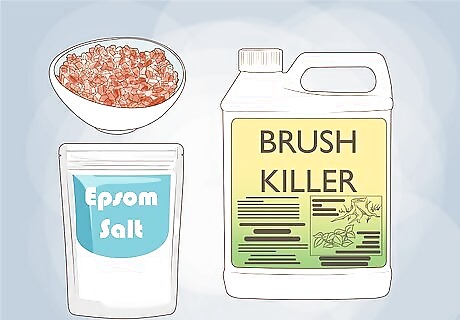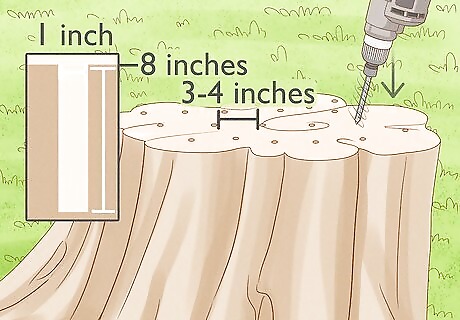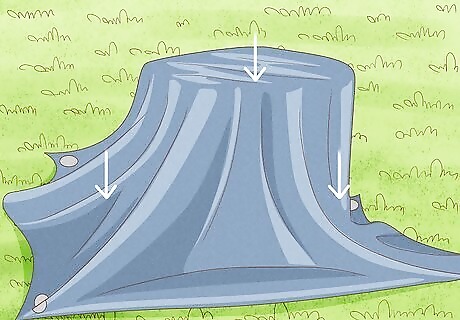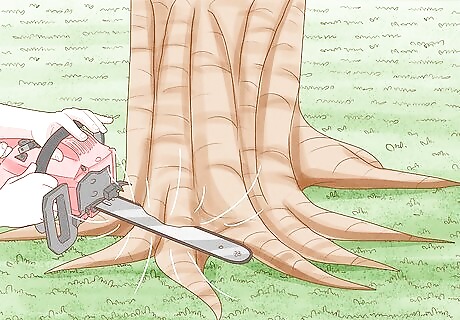
views
- Drill several deep holes into the stump and fill them with Epsom salt or herbicide to kill the stump from the inside out.
- Cover the stump with an opaque tarp for several months to deprive it of sunlight, which will gradually kill and rot the stump.
- Douse the stump in kerosene or use charcoal to burn the stump away.
- Use a stump grinder, chainsaw, and a shovel to grind and chop the stump away.
Using Salt or Herbicide

Obtain Epsom salt, rock salt, or brush killer. Using Epsom salt or rock salt is an easy way to kill a stump on the cheap. It takes several months for the stump to die, so it might not be your best bet if you need to get rid of the stump quickly. An herbicide like brush killer, however, is both more reliable and faster-acting. Do not use regular table salt, which is harmful to the soil surrounding the stump. Use 100% Epsom or rock salt with no added ingredients to avoid disturbing the land and plants around the stump. If you decide to use herbicide, use an product containing glyphosate or triclopyr. While a chemical herbicide will kill the stump faster, keep in mind that it could kill the roots of surrounding trees or shrubs as well.

Drill 1 in (2.5 cm) holes in the stump. Drill several, roughly evenly-spaced holes across the surface of the stump, so the salt or herbicide will be able to penetrate into the wood. Make the holes about 1 inch (2.5 cm) wide and at least 8 inches (20.3 cm) deep, and space them about 3–4 in (7.6–10.2 cm) apart. Aim to drill about 6 holes, or more for a larger stump. If you don't have a drill bit this long, use an ax to chop into the wood and make gouges as deep as you can. If you're working with a stump that has large above-ground (aerial) roots, drill holes in those as well.

Pack the holes with salt or herbicide, water, and wax. Fill up the holes 3/4 full with Epsom salt or rock salt. Don't forget the holes you drilled in the aerial roots. Then pour a small amount of water into the hole—just enough to cover and moisten the salt. Finally, light a plain, unscented candle and drop wax into the holes to plug them. If you’re using herbicide, consult the instructions on the packaging for proper application. Some require a particular ratio of herbicide to water for effective use. It's important to make sure the salt stays in place, rather than scattering over your yard, since excess salt can be harmful to topsoil and the roots of other plants.

Cover the stump with an opaque tarp. Put a plastic tarp, trash bag or another nonporous item over the stump to cover it. The tree stump will die more quickly without sunlight and rain to continue nourishing any shoots that come up. After 6 weeks to several months, the stump will die. Check on it every once in a while to see how things are progressing. When the stump is dead, it will begin falling apart on its own. After the stump has died, remove it with a stump grinder Or dig it out.
Covering the Stump

Cover the stump with an opaque tarp. This method is low-cost, but can take a long time—up to several months. The tarp slowly kills the stump by denying it sunlight. Put a dark tarp or trash bag over the stump so it won’t receive sun or water. Stake the tarp to the ground so it doesn’t get removed by weather or wildlife.

Wait 3 to 6 months for the stump to die. During this time, the stump will slowly wither and begin to rot. Check on it from time to time to see how things are progressing. To speed up the rot, add a scoop of nitrogen fertilizer on top of the stump every couple of weeks. Alternatively, use a stump removal solution to speed the process along, which is often available at nurseries and garden centers. In addition, pour some Epsom salt into cracks that appear in the stump, or drill holes in the stump and fill them with salt to make it go faster.

Cut away any saplings that crop up. As the stump dies, it may send up shoots in an attempt to regrow. Until the stump is dead, cut saplings off the base of the trunk as they sprout, or paint them with a woody brush killer that contains triclopyr. If your goal is to allow one tree to grow from the old stump, cut off additional saplings and do not apply an herbicide. Once the stump has died, it will take up to 10 years to decay naturally, or it may be removed using a grinder or other tools.
Burning the Stump

Drill holes in the stump. Burning a stump is a good way to remove the stump after you have killed it. Start by drilling plenty of holes across the surface of the stump about ⁄2 to 1 inch (1.3 to 2.5 cm) wide and at least 8 inches (20.3 cm) deep. Penetrating deeply will ensure the stump gets burned down to the tips of the roots so that it will be easy to remove.

Pour kerosene into the holes. Soaking the stump with kerosene will enable you to light it on fire so it will burn into ash. Make sure the stump is fully saturated, or the fire may go out before it reaches the tips of the roots. About 1 US qt (0.95 L) of kerosene is enough to burn most stumps. Don’t use diesel fuel, which burns too quickly to be effective and is more harmful to the soil than kerosene. Check local city ordinances to make sure it’s legal to do a controlled burn.

Build a fire on top of the stump. Put scrap wood on top of the stump and use a fire starter to ignite it. As the fire burns down, the stump will catch and burn up. Monitor it closely to make sure the stump actually catches, and add more wood as necessary to keep the fire going. Alternatively, pile charcoal on top of the stump and light the charcoal on fire. The coals will slowly burn down through the stump. This method reduces the chances of burning nearby plants. Be sure to monitor the stump as it burns to ash. Don’t leave it unattended, in case the fire gets out of hand. Depending on the size of the stump, the burn may take several hours.

Dig out the ashes and fill in the hole with soil or mulch. Use a shovel to remove all of the ashes, down through where the roots were, and fill in the hole with fresh soil. Dispose of the ashes in a garbage bin, or distribute them over your garden for use as a fertilizer—wood ashes are a valuable source of nutrients for plants!
Grinding the Stump

Purchase or rent a stump grinder. A stump can also be removed by physical means. Rent a stump grinder from a home improvement store. This machine has a rotary cutter that drills into and grinds up the stump, and is ideal if you have a huge, stubborn stump you need to remove. Renting a stump grinder is often the most cost-effective solution, but if you have a lot of stumps to grind, it may be worth a full purchase. Use protective equipment, too. Goggles and a mask will protect you from sawdust and flying wood chips. If you don't enjoy handling heavy machinery, hire a landscaper or another professional to remove it for you.

Cut the stump close to the ground with a chainsaw. Use a chainsaw to level off the stump just a few inches from the ground. Remove any branches or roots that stick up too far off the ground so that the stump grinder will have a stable surface on which to operate.

Grind up the stump. Put on your goggles and mask, and position the stump grinder over the stump. Then, following the manufacturer’s instructions, move the grinder slowly across the stump's surface to grind it up to bits. Continue along the aerial roots to grind those as well until the stump has been fully ground up. Be careful not to get your feet in the way of the grinder. Wear heavy boots so you won't accidentally hurt yourself. Make sure children and pets are safely away from the equipment before you begin operating it.

Shovel out the grindings and fill in the hole. Remove all of the wood chips and discard them (or use them as mulch), then fill in the hole with soil. Use an ax to chop out any remaining roots.
















Comments
0 comment